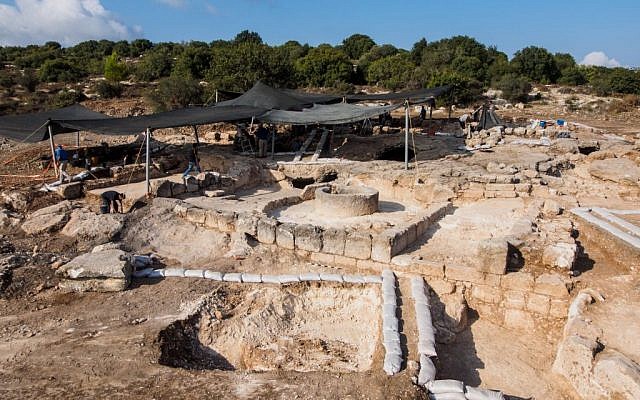The Israel Antiquities Authority reported on Thursday that archaeologists have discovered what they think to be the remnants of a Byzantine monastery outside of Beit Shemesh, west of Jerusalem.
Archaeologists surveyed the area during the development of the Ramat Beit Shemesh neighborhood and discovered the remains of old walls and cisterns. The site’s subsequent excavations turned up an oil press, a wine press, and mosaics.
 Remains of what archaeologists believe is a Byzantine monastery found near Beit Shemesh.
Remains of what archaeologists believe is a Byzantine monastery found near Beit Shemesh.
The size and scale of the installations indicate that production was on an industrial scale, and that the residents relied upon the sale of wine and olive oil for their livelihood.
One of the mosaics found at the site bears colorful geometric designs, a cluster of grapes and flowers.
Although a church or inscription has yet to be found in the complex, archaeologists posit that the site was a Byzantine monastery, dating back some 1,500 years, based on the site’s style and dating.
 A mosaic found at what archaeologists believe is a Byzantine monastery found near Beit Shemesh.
A mosaic found at what archaeologists believe is a Byzantine monastery found near Beit Shemesh.
“The impressive construction, the dating to the Byzantine period, the magnificent mosaic floors, window, and roof tile artifacts, as well as the agricultural-industrial installations inside the dwelling compound are all known to us from numerous other contemporary monasteries,” IAA excavation directors Irene Zilberbod and Tehila Libman said in a statement.
“Thus it is possible to reconstruct a scenario in which monks resided in a monastery that they established, made their living from the agricultural installations and dwelled in the rooms and carried out their religious activities.”
The new neighborhood will be constructed around the site and the archaeological remains will be preserved and developed as a landmark, the IAA said.
 Aerial photo of remains that archaeologists believe were a Byzantine monastery found near Beit Shemesh.
Aerial photo of remains that archaeologists believe were a Byzantine monastery found near Beit Shemesh.
Earlier this year archaeologists unearthed a Byzantine monastery near the entrance to the Bedouin village of Hura in the Negev Desert adorned with stunning mosaic floors.
Source: archaeology-world.com







